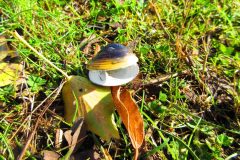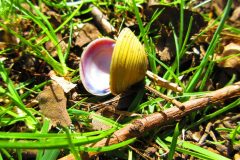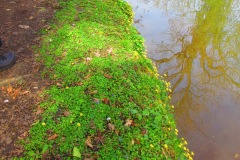Monday, 31st March 2025
On a beautiful spring morning at the end of March, John and I went for a walk along the Chesterfield Canal. Parking on Wiseton Road just outside Clayworth, we set off from Clayworth Gray’s Bridge (Bridge 69), walking towards Wiseton and almost immediately began to see empty bivalve shells.
These as can be seen, especially from the second photo, are clearly ridged. In the third photo, if you enlarge it and look carefully at the foreground, you can see how the predated shells were left scattered along the side of the towpath.
After some research I discovered they were freshwater Asian Clams, Corbicula fluminea, an invasive species that was discovered in the River Trent in 2007. We began to see them almost immediately we joined the canal at grid reference SK723887 and continued to see them for some distance until grid reference SK720892, over half way along the straight stretch of canal that meets with the lane into Wiseton.
In all the years we’ve been walking along the Chesterfield Canal, this is the first time we’ve seen them anywhere along the canal. I was curious as to what may have been fishing them out, eating them and discarding their shells? There had been some work carried out along the canal, involving cutting back vegetation along the edge of the canal and towpath, and John wondered if this might have had any bearing on what had happened.
Great Spotted Woodpecker’s early drumming
Great Spotted Woodpeckers are regular visitors to our Finningley garden peanut and fatball feeders. Last week, the male was recorded most days and this week it was the female I kept seeing. However, at 10.30am on Thursday 30th January we heard one of them drumming very loudly close by though we couldn’t actually see the bird. Although we do often hear Woodpeckers drumming close to home, I don’t think I’ve ever heard one drumming so early in the year before.


